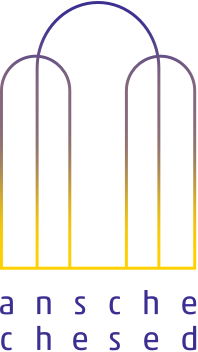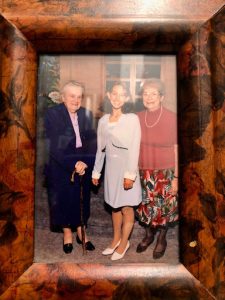Bat Mitzvah at 100: Member Reflections | |
Deborah KaymanIn June, 1963, I was the 2nd girl in my Conservative shul (Jamaica Jewish Center) to celebrate becoming a Bat Mitzvah on a Shabbat morning. (The 1st was the rabbi’s daughter, perhaps 10 years earlier.) My father prepared me to read the maftir aliyah from the Torah scroll and to chant the Haftorah and its blessings. To keep the peace, however, the ritual committee decided that, technically, the aliyah would not be mine. When the maftir aliyah was called, my father and I went up to the bimah together. He chanted the blessings and I read from the scroll. The photo is the only one I have from the day. Most likely, the photographer was my dad. In the photo with me are my father’s parents and sister and my cousin Malcolm, the elder of her 2 sons. We are standing in front of the house in which I grew up, where my father continued to live until his death 2 years ago this month. | 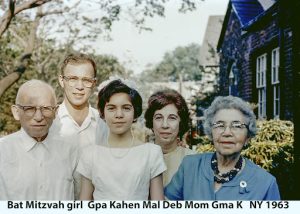 |
Erica GruenI memorized my Haftorah by listening to a record, dropping the needle over and over and over! In my Reform temple at that time, we read from the Torah on Friday nights, not Saturday mornings. I learned all the before and after blessings. Afterwards, my parents hosted a luncheon for relatives at a nearby restaurant and an open house in their home for friends the next day. I was their oldest child and this was a very big deal for them and for my two grandmothers, both of whom were immigrants to this country. Very memorable and I still have in my home many of the presents I received! | 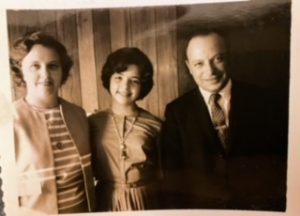 |
Helen RubinsteinMy Bat Mitzvah was on my 13th birthday in 1963. Our conservative temple only held them on Friday evenings. We learned to chant our haftorahs (mine was Chayei Sarah) but could not read from the Torah. I was the first girl from both sides of my family to be Bat Mitzvahed. | 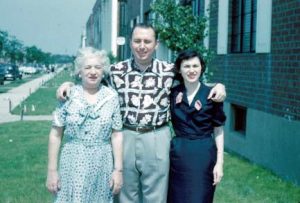 |
Fran GordonMy original date was March 26, 1971 at Beth El Congregation in Akron but because our rabbi was going to Israel, my date was moved up to February 19, 1971. Despite the change of date, I still read the same Haftarah reading as the service was on a Friday night. My searing memory is the moment I lost my place due to the glare of the light on the plastic cover of my Bat Mitzvah book. My big brother Scott helped me find my place and resume my reading. | 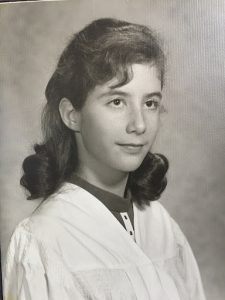 |
Cecile KuznitzMy Bas Mitsvah was unusual in that it took place in an Orthodox shul. The rabbi, Samuel Landa o”h, came up with a creative solution: he arranged a Torah service on a Sunday and I chanted Haftorah without the blessings. I am grateful that Rabbi Landa was flexible enough to give me this opportunity. Today, women cannot go near the bimah and I do not go near that shul. | |
Ruth SalzmanMy Conservative shul in downtown Manhattan had a few banot mitzvah when I came of age in the 1960’s but it was far from the norm, and my mother – though undeniably empowered in all things – was a firm believer in “Viva la difference” when it came to gender roles. So I missed this rite of passage, but never quite got over thinking about it. In 1987 our family moved from downtown Manhattan to the Upper West Side and joined Ansche Chesed. I was so intrigued by seeing all the women who led services, chanted haftarot, gave drashim and leyned, who felt completely at home. It felt so beyond reach, but tantalizing. Bat mitzvah seemed like a beckoning doorway to owning my own place as an adult Jew. Adult bat (and to a lesser extent bar) mitzvah was kind of becoming a thing, a second chance. I incubated the idea for a while as we got acclimated to our new shul and our new neighborhood. I was struck by how common it was for AC members to help each other in learning all the skills and started to casually mention my interest in adult bat mitzvah. Ora Shtull, a former AC member, didn’t miss a beat and stepped up without hesitation. “I’ll teach you!” she said. I wasn’t sure if I was delighted or terrified (a bit of both), but it was a chance I couldn’t afford to miss. And with my older child’s bar mitzvah coming up in a couple of years I wanted to try and make it happen beforehand. I feared I would feel like only “a lady with a hat” at his bar mitzvah if I didn’t take this on and take my own place. Ora, who – in a lovely bit of serendipity – shares my birthday in early April (a dozen years later, but what were the chances?) decided that Lech Lecha would in fact be the perfect parsha for an adult taking this journey. She is an outstanding and knowledgeable teacher, and I was too in awe of her to back out. In the fall of 1991, I became a bat mitzvah and put on a tallit for the very first time. I’ve never felt like a bystander at services since that time, it is truly one of the best gifts I’ve ever given myself. | |
Debra Greenberg“Speak to Aaron and have him light the menorah so that the seven lights shall cast light,” Numbers 8:1–14. Haftorah for Behaalotecha. Fifteen years ago, six bat mitzvah sisters – Amy Zarrow, Arleen Stern, Linda Messing, Hannah Lipman, Sheila Lewis and I, came together to study Torah together with Rabbi Kalmanofsky and Hazzan Hirschhorn and each other, in preparation for our bat mitzvah. We studied about the menorah and its seven branches which Reb Schneur Zalman describes as holy paths – like kindness, compassion or strength: the seven paths, not all the same, and are not all meant to be. During our learning together we discovered many ways to share that light, though it is often hard. We explored what lights us up, what feeds our light and how do we share that light? These questions continue to resonate particularly during the last two years. A lot has changed for all of us during this time. Our hearts have been battered through the stresses of the pandemic and now the war in Ukraine. So what does this group of bat mitzvah sisters do in the face of all of that? The short answer is that each of us has continued sharing her light, with our families, friends and communities. We are mindful of the women who came before us beginning one hundred years ago, of those who have come since 2007, and those who will continue to come and we are extremely grateful for all of their light too. | |
Sheila LewisIn June 2007, six or so of us were inducted into AC’s First Bat Mitzvah cohort of older women, recruited by Rabbi Jeremy. Raised an Orthodox yeshiva girl for whom Talmud got swapped out in sixth grade for tuna-sandwich making for the boys, I was an unlikely candidate. Still, no reason not to join when I realized that we could share the burden, and the Aliyas would be short. Rabbi Jeremy selected B’Halotcha, a juicy parsha. Rich imagery, starting with ill-fated quail-eating, led to the pinnacle, Miriam’s outing from the community. She spent seven days repenting for her criticism of Moshe (and the patriarchy?) or on a spiritual retreat, depending on your interpretation. I gladly took that part for our collective Divrei Torah. Miriam, on the outskirts, looking inward, comes out chastened, but wiser; she was my heroine. All these years later, women are still claiming their voice. Perhaps the younger ones will actualize from a point beyond this struggle. We will not all become rabbis, leaders, or teachers, but we all can aspire to speak from the eloquence of the heart. Thinking back to that celebration, my favorite moment was bringing my mother to the bimah, for her first Aliyah. She, too, overcame initial resistance and stepped past the sidelines. May our stories be heard and shared with fresh resonance for these times. | |
Elana GoldbergMy Bat Mitzvah was also a few days following Purim which seemed appropriate because that is a) when my Hebrew birthday is and b) I LOVE Purim. I remember that people brought their extra candy from their Mishloach Manot to throw at me. In the 7th grade this year, I taught the students that Purim is all about embracing your Jewish identity even when it is hard. As American Jews, we, like Esther, live between two worlds. Her lesson to us is to show us that we can balance both our Jewish and secular identities and be successful and fulfilled people. Finally, at the time of my Bat Mitzvah, I didn’t realize that I would be doing this type of work. I’ve always enjoyed Torah study so studying for my Bat Mitzvah was “easy”. It was something I looked forward to rather than a chore. That is something that I think about and try to emulate every day in my work. Torah story should feel enjoyable and “easy” because it is a part of who we are. The word “Tzav” reminds us that we are beholden to this important text. | |
Amy MarxI celebrated the 50th anniversary of my Bat Mitzvah last month. It was held on Friday evenings. Several years later, everyone celebrated their B’nai Mitzvah on Shabbat morning. How things have changed and certainly for the better. Yet, I loved my Bat Mitzvah and hold the memories in my heart. I also shared the same Haftorah with 2 of my 3 children. | |
Rachel MannI had a Friday night bat mitzvah as was the tradition in my Conservative shul in 1988; girls weren’t allowed to participate in the Shabbat morning service. I led Kabbalat Shabbat (but not Ma’ariv), and read a few chapters of Shir HaShirim from a scroll that my father tracked down and acquired for this very purpose; he wanted me to have an experience like the one my brothers had reading Torah at their bar mitzvahs. My grandmother, a talented needlepointer, made a beautiful original cover for the scroll. It was a very special and unique bat mitzvah, conceived with love. | 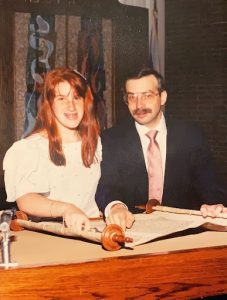 |
Sidney GribetzMy reflection is upon my mother, Jessica Shapiro Gribetz, who was in the first cohort of women, following Mordechai Kaplan’s daughter, to celebrate bat mitzvah. In my family, it was always mentioned as a proud accomplishment and important lesson. | |
Diane FingerHaving a Bat Mitzvah in the 1960’s was considered quite a step away from tradition — some families felt they were making a statement in sending their daughters to Hebrew School. I was the first girl in my mother’s clan to have a Bat Mitzvah. My Bat Mitzvah was on a Friday evening, and I remember singing several songs and psalms from the Kabbalat Shabbat service and chanted the week’s haftorah. The memory that has stayed with me is looking around at many of our relatives, and being amazed that a great-aunt, a stand-in for my grandmother, was sitting at the side of the sanctuary. It was obvious that she was seriously affected by dementia, but her family went to the trouble of bringing her. | |
Gila LiptonAt age 12 I was one of 8 girls graduating from the 8th Grade of the Sunday School of Temple Emanuel in Boro Park, Brooklyn, a large, Conservative Shul. It was 1952, but there was no mention of a Bat Mitzvah celebration. For 8 years we had learned about Jewish History & Customs, we sang songs, sometimes did some Arts & Crafts, celebrated Israel’s Statehood, learned the new verse of Hatikva & were reminded to now say “Israel” instead of “Palestine.” Most of the Sunday School teachers were Orthodox. Much of our learning was by rote. There was no Hebrew instruction. Somehow, I did not connect with the other girls in the class. Their parents were members of that shul & mine were not. The equivalent of Bat Mitzvah was our confirmation. It was held in the main sanctuary on the 1st Day of Shavuot. We sat on the Bimah, During the Service we did some recitations and sang some songs. I was honored to deliver the Valedictory speech, but I no longer recall what I said. And that was it. Except for one important aspect – each of us was given a Tanach, inscribed with our name & the date & place. The rabbi instructed us to read it again & again & if it fell apart we were to return & receive a new one, to be given with pleasure! (I will get back to this later). Celebration? No. This calls for some background information. For many years, starting before I was born, my father, Rabbi Walter Duckat (Z’L), taught 5th grade at that Sunday School. It was not located near where we lived! It was an uncomfortable train and bus trip to get there from our Brooklyn location. Nobody thought ahead! Since people would need to travel for my Boro Park Confirmation Service, nobody was invited. And we did not know the congregants. My father had his Bimah at the Jewish Guild for the Blind in Yonkers. He was there & did not attend my Confirmation. Since I was not allowed to travel alone, my Mom reluctantly came with me & brought my younger brother. At the end of the Service, on the way home we stopped to visit my FRUM great aunt, bedridden towards the end of her life. She was excited for me! She wished me Mazal Tov! That was the only acknowledgment and greeting I received from anyone. I still cherish her response. I did not return to Temple Emanuel. I studied Hebrew in public High School. I kept kashrut & Shabbat & Holiday observances as much as I could. I did not go to shul. Fast forward about 30 years. I was married & a Mom, living on the UWS, when my father died in 1983. I felt the need to say Kaddish. A non observant neighbor said, “Go to the WSM. They sing nicely.” So I went. I was immediately magnetized. I was embraced warmly! Someone helped me follow the Siddur. Someone gave me “sheets” for Haftorah Trope. Mowsh gave me a start! That summer, we traveled to CA via Amtrak. 3 days there, 3 days back & I learned Haftorah trope. Next summer, same trip, but this time with Torah Trope. And in the next 14 months, going to & from work via subway, I learned the “brachas” before & after Haftorah. Then, shy, I volunteered to layn Maftir & chant Haftorah Vayera. Only my husband & son knew that this was going to be my BAT MITZVAH! At home, Ed gave me a T shirt that said, ” I DID IT.” I was happy. I felt complete. I never told anyone at WSM, but my gratitude remains passionate! Ever since, I began to help others. I had listened to the rabbi at Temple Emanuel. I read my Tanach over & over. 3 years ago the binding wore out. I decided to return, to ask to speak with the Graduating Class, to tell them of my Jewish Journey to become Bat Mitzvah. Alas…There is no more Temple Emanuel in Boro Park. That large congregation dissolved over the years. The site of the shul is a parking lot. I repaired my Tanach. I still use it. “Presented by Temple Emanuel, Shevuoth, May 30, 1952” | |
Guess Who?
| |
